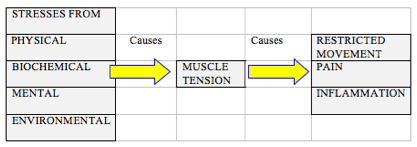Why do we get back pain?
Why do we get back pain and structural problems?
Analogy
Think of a push through door that closes by the action of balanced springs. In this analogy the door itself and the frame represent bones, the springs are the muscles, the hinges are joints, ligaments and discs. If the springs go out of balance the door will rest slightly open. On examination one spring will appear tight/ short the other lengthened or loose; leaving the door in this state will stretch the ligaments and damage the disc and joint; eventually the door will fall off its hinges! Similarly in the body as muscles weaken or go into spasm the affected joints suffer and become restricted, painful and ultimately damaged or arthritic.
Uncorrected muscle imbalance leads to ligament and disc damage.
Level 1: MUSCLE Muscle imbalance begins due to stress. Stress is anything that overwhelms the system. It can be mechanical, biochemical or mental. An example of each would be:
- Mechanical: e.g. a whiplash – is an example of an acute mechanical stress; Poor ergonomics at work due to incorrect seating, desk or monitor height is an example of a chronic structural stress. Dental work may cause jaw muscle or bite imbalance that in turn effects the neck muscles and elsewhere.
- Biochemical causes include nutritional deficiency, infection, toxicity and allergy. For example magnesium is necessary for normal muscle tone so a deficiency might cause a weakness or cramp. In the allergic person there may be specific or general muscle weakness. In AK each muscle is related to a different organ so each muscle may be affected by different allergens or irritants.
- Mental causes include emotional conflict from other people or even imagined problems. Repeated or persistent stress creates patterns of muscle tension which cause us to favour one leg or to lean a certain way, hold our head crooked and so on. This stress may remain subconscious or may give rise to pain – which alerts us to a problem. Stress affects muscles by altering one of the control mechanisms, these include the cranial sacral mechanism which is the brain and spinal cords circulation, the nerve supply at the spine or elsewhere, the blood supply, the lymph drainage or the acupuncture meridian.
Level 2: LIGAMENT Eventually the ligaments, which hold the bones together, become ‘stretched’ through constant muscle imbalance. They do not really stretch, they tear (sprain) which allows instability in the affected area like the low back or the neck. The body attempts to stabilise the area by increasing muscle tension; chronic or longstanding muscle tension is like cramp and becomes increasingly painful. While moderate to severe pain is likely in level 2, there may be a pattern of good and bad days/periods. Pelvic pain may be compounded by jaw/ bite and foot mechanics.
LEVEL 3: DISC If the ligament remains unstable then the discs may become damaged themselves. Discs have a similar composition to ligament tissue with a fluid filled centre and can bulge or burst under stress. Disc prolapse often causes aching or intense limb pain e.g. sciatica which is leg pain. In treatment we try to reverse the process above. By finding the cause of muscle imbalance we can balance them so that the discs, ligament and surrounding tissues are not under stress and are able to heal.




